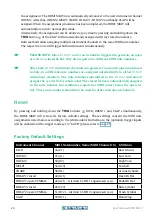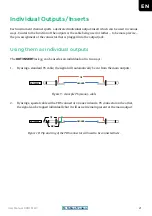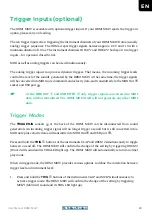
☛
Various types of percussion sounds are possible by just using the filter section
of the snare drum but leaving out the
NOISE
component. When
FILTER
and
RESONANCE
controls are fully opened, the result will sound clave-like. By
attenuating
RESONANCE
, this sound will morph into a snare that resembles
a preset beat-box from 1978 or thereabouts. Decreasing
FILTER
frequency in
combination with various
RESONANCE
settings will yield convincing renditions
of tom-toms, congas, and bongos (see “SNARE” on page 15).
HI HAT 1/HI HAT 2
Figure 7: HI HAT 1 instrument channel of the DRM1 MKIV - HI HAT 1 and HI HAT 2 are identical
These two instrument channels are meant to create hi-hats but also cymbal sounds. Come up with
a wide range of cymbals, percussion and sound effects, based on filtered noise and a metallic-
sounding blend of oscillators.
DECAY
sets the release time or the duration of a sound.
FILTER
sets the cutoff frequency of the low-pass filter, coloring the overall sound of the
channel.
BEND
adjusts the amount of an optional modulation of the cutoff frequency by the
DECAY
envelope. In its central position, no modulation is present. Turning the control
clockwise from its center position will modulate the cutoff frequency of the filter,
lowering it. Moving away counterclockwise from the center position will invert the
modulation, resulting in a rising cutoff frequency. This modulation interacts with
the
DECAY
setting.
ATTACK
adds a short fixed-level transient spike to the initial attack of a sound to enhance
presence of the hi-hat and cymbal sounds. Always adjust
ATTACK
in correlation
with the complete mix. The pitch of the transient spike can be adjusted in parallel
with the oscillator mixture, using the
PITCH
control.
RESONANCE
specifies the intensity of the filter resonance which, consequently, shapes the timb-
re of the hi-hat and cymbal sounds.
User Manual DRM1 MKIV
16
Summary of Contents for DRM1 MK4
Page 1: ...USER MANUAL DRM1 MKIV...






































